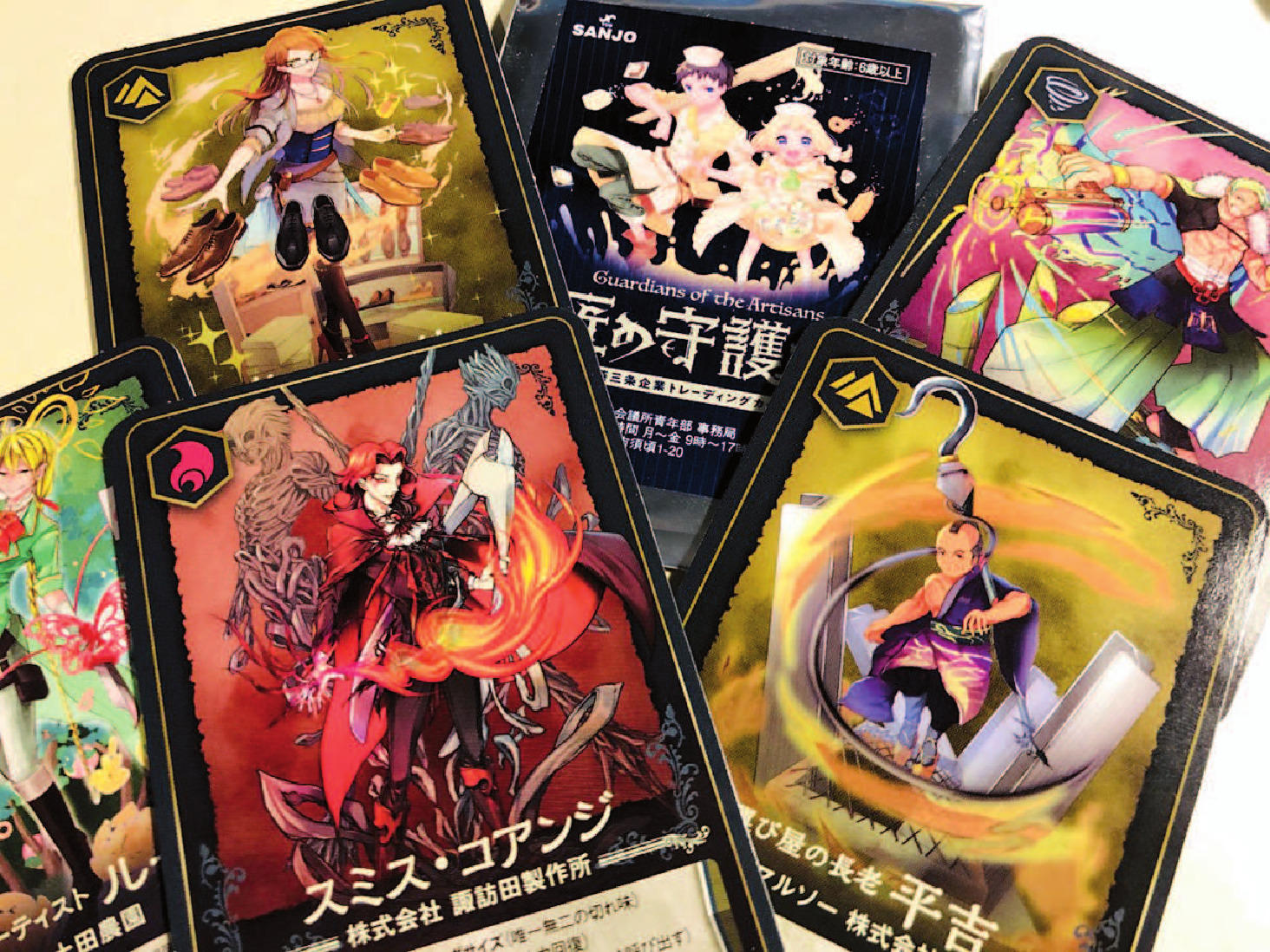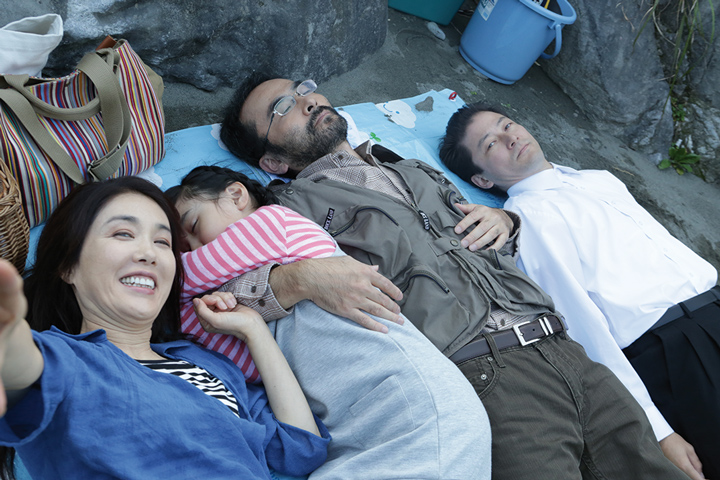

Tourists can leave Sanjo with playing cards to collect and trade, which honour local artisans.
Although it does not enjoy the same advantages as largest cities, this small town is not short of ideas to attract visitors.
Though Tokyo and Japan’s larger cities appear not to be suffering the massive depopulation currently affecting the rest of the country, it is a different matter in the rural regions. The facts are uncompromising and speak for themselves: countless villages and small provincial towns throughout the country are dying rapidly. Sanjo (adjacent to the city of Tsubame), situated around 60 kilometers from the sprawling city of Niigata, is among those formerly prosperous places that, in fewer than twenty years, have become “shutter gai”. The term is based on a powerful image: “iron curtain town”, harking back to shoten gai (shopping district), the lungs of the country’s cities, and referring to those city-centres where one is more likely to find shops with their shutters down rather than up. Simply walking through the previously lively and bustling city-centre of Sanjo is enough to depress the happiest of tourists. Sanjo has all the appearance of a phantom city with the town hall recently recording only around 100,000 inhabitants. Moving a short distance away from the city-centre, the impression that the town is deserted is intensified. There are dozens of empty houses, abandoned after their owners have died. Where is everyone? Where have the young people from Sanjo gone? “They are all in Kansai (Osaka region) or Kanto (Tokyo region),” states an elderly man, surprised to meet a foreigner wandering around…
Is Sanjo totally without charm? Let’s not beat about the bush: open any tourist guidebook about Japan, whether in French, English or any other language, and you will find nothing about the two adjoining towns of Tsubame-Sanjo. When the guides mention the region, they only refer to Niigata (its rice and sake), Nagaoka (see pp.13-14), or beautiful Sado Island. But, despite its high-speed train station, there is not a word about Tsubame-Sanjo! And for good reason, touristically speaking, as these two cities have nothing spectacular to offer. Here, the plain is monotonous, with no natural hot-springs, no temples or shrines to attract pilgrims, even fewer summer festivals to encourage crowds of visitors from neighbouring provinces. As long as it can be remembered, Tsubame-Sanjo has been an industrial dormitory city for the thousands of people employed in the metalworking factories. Despite this gloomy observation, Tsubame-Sanjo can be proud of something – its know-how in the field of metallurgy dating back to the Edo era (1603-1868). Even then, the unequalled technical skill of the region’s craftsmen attracted the attention of lovers of fine metal objects. Travellers were delighted to carry home such souvenirs as beautiful kiseru (long metal tobacco- pipes), razors or ink pots. The first factories produced, on a large scale, the most reliable nails, pincers, knives, saws, hammers and planes in the country. Tsubame-Sanjo has enjoyed its first-class reputation since the 18th century when some of the workshops still in existence today were first set up. Several centuries later, when national requirements for iron and steel expanded rapidly, this craftsmanship gradually evolved into a flourishing industry. Japan needed reliable dies and moulds to manufacture parts necessary for the production of tanks, aeroplanes, weapons, and millions of other, thankfully, less offensive items. The factories in Tsubame-Sanjo were often called upon to provide them, so the city prospered by contributing to the country’s industrial growth before as well as after its defeat in the Second World War. There was an immediate consequence: during the Edo era, the many temples, shrines and elegant gardens in the region’s cities and towns were razed to the ground to make way for new, larger and more efficient factories. Economically speaking, Tsubame-Sanjo was at its peak towards the end of the 1960s. Hundreds of factories and workshops opened to manufacture tools and machines of astonishing precision and complexity. This know-how quickly spread beyond the country’s borders. Have you heard of the following Japanese brands: Tojiro, Gyokusendo, Suwada, Aida Godo, or Kondo? Almost certainly not, unless you are a carpenter, cook, hairdresser, gardener, or manager of a beauty parlour. These prestigious brands are the joy of craftsmen, great chefs and other skilled artists worldwide, who want their tools to be strong, reliable, and aesthetically beautiful. And this is still the case today. Though the heavy metal industry is not flourishing as it was during the period of Imperial ambition, small-scale Japanese metalworking in Tsubame- Sanjo still prospers thanks to national and international word-of-mouth recommendations. So you see, not all is lost for Tsubame-Sanjo. And, on discovering that these last few craftsmen in the city had a cult following among countless restauranteurs, carpenters, gardeners and hairdressers around the world, the local authorities have decided to take a gamble. “Here, we have neither petrol nor shrines, but we do have craftspeople!” could be happily displayed at the entrance of the station. This is the reason why, over the last few years, with local authority support, almost all the factories have opened their doors to show-case their skilled know-how to curious travellers. Now, it is possible to visit the artisans’ mini-museums to buy items directly from the factory or have fun taking part in activities connected to metalworking. The region’s schools are scrambling to keep up! And if you want to discover how to manufacture spoons, you need to be aware that some visits and activities are offered in English. For instance, in 2011, the Suwada factory completely renovated its premises to open a splendid “open-factory” where you can watch craftspeople working the metal from behind large windows. Its very impressive, surprisingly exciting, and free. Of course, a visit to the shop means you can leave with one of the many items regularly awarded prizes in national competitions for “good design”. The company’s best-seller is a pair of nail clippers. Suwada sells tens of thousands of them around the world every year. When I heard how many, I was understandably surprised. All these people are ready to pay around £42 for simple nail clippers? Having done their research, all the factories in the area mainly work with the luxury goods industry. As for our famous nail clippers, they are obviously bought in large numbers by beauty salons or high-end manicure salons, which snap them up. “Try them, you’ll see the difference!” it was suggested to me. So I tried, and yes, there was a real difference compared to my (already rusty) nail clippers bought in a discount store. Tsubame-Sanjo’s Shinkansen station has also begun to promote local goods. You can’t miss Tsubame-Sanjo Wing’s 800 m2 on the concourse level next to the platforms, where work produced by all the regions’ artisans is exhibited. There are hundreds of day-to-day objects (chopsticks, bowls, cutlery, razors, etc.) displayed in splendid showcases, with accompanying video clips, alongside more complicated tools such as steel parts for industrial machines, which require the very best in terms of precision (engines, turbines, etc.). To ensure visitors are aware of the excellent standard of the work produced, this ambassador for local trade is happy to highlight certain products, for example, the luxurious table settings “used in several of Joël Robuchon’s restaurants”. In addition, a sign recently placed at the entrance proudly announces that the cutlery used in the most popular TV culinary drama series of the moment, Guran Mezon Tokyo (Grand Maison Tokyo), on TBS, featuring KIMURA Takuya who hails from Tsubame. If any fans of the star pass by, they will undoubtedly fall for a full set of knives and forks. Finally, just for fun, there is another amusing local initiative: just like the Pokemon playing and trading cards, you should know that there is now a game called Guardians of the Artisans. But, instead of the famous little Nintendo monsters, the characters featured on these cards are all artisans who work in the region’s factories! These initiatives set up to attract and seduce tourists are just a very small selection of the projects launched in Tsubame- Sanjo. Do they have any real effect? We were not able to get any official figures for the number of visiting tourists, but according to the few factories we contacted and the salespeople at Wing “tourists are gradually returning”. Whatever the case, the local inhabitants are working towards making a success of their efforts and believe in their ability to attract more tourists. And their belief is as strong as iron…
FLORENT GORGES










